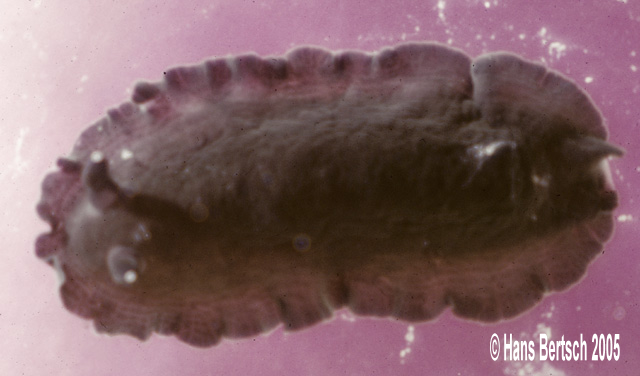 |
Dendrodoris krebsii
Photo courtesy of Hans Bertsch
Dendrodoris krebsii (Mörch, 1863)
First, my apologies for the quality of the photographs. They were taken in 1974, with an old camera, and long before Terry Gosliner , Mike Miller and I had perfected the art of “tub shots.” Hence, a plastic aquarium with a colored piece of paper background. The colors and shapes of the animals are true and useful for this discussion.
Recently I spoke with Webmaster Mike Miller about the paucity of Caribbean nudibranchs as BOWs. This species begins an intermittent series about animals from this geographic region.
Dendrodoris krebsii has an intriguing biogeographic and taxonomic history. This is summarized in the paper by Valdés et al., 1996, “Review of the genus Dendrodoris Ehrenberg, 1831 (Gastropoda: Nudibranchia) in the Atlantic Ocean.” Their opening Introduction sentence clearly states difficulties in identifying species: “The absence of radula and the variability of colour, makes the previous classification of Dendrodoris species highly subjective.”
This species has been reported in the tropical western Atlantic, from Georgia, USA, to Brazil. Originally named Doris krebsii, recognized synonyms are Doridopsis pellucida Abraham, 1877, and Doriopsis atropos Bergh, 1879.
The highly variable body color can be white, yellow, brown, black, or red. The rhinophores are relatively small in relation to the body size, and share with the gills the same color as the body. Juveniles are equally variable in coloration.
Valdés et al. described the egg mass : “The egg is spirally coiled, 5 mm in height and 0.4 mm width. The eggs , yellow in colour, are arranged in parallel lines of about 20, and protected into a spherical capsule. Eggs measured 62-72µm (mean 66 µm). Capsules measured 83-93 µm (mean 85 µm).”
This species does not occur in the eastern Pacific, despite reports of it as Dendrodoris atropos or Dendrodoris krebsii by Collier & Farmer, 1964, and Keen, 1971, et al. The eastern Pacific species , from the Sea of Cortez south, is currently considered the Indo-Pacific D. nigra, although it may be an undescribed species (Millen & Bertsch, in press).
References
Collier, Clinton L., and Wesley M. Farmer. 1964. Additions to the nudibranch fauna of the east Pacific and the Gulf of California. Trans. San Diego Soc. Nat. Hist. 13 (19): 377-396.
Keen, A. Myra. 1971. Sea shells of tropical west America. Marine mollusks from Baja California to Peru, second edition. Stanford University Press, Stanford, CA. xiv + 1064 pp.
Millen, Sandra, and Hans Bertsch. In press. Two new species of porostome nudibranchs, Family Dendrodoridae, from the coasts of California (USA) and Baja California (Mexico). Proc. Calif. Acad. of Sci.
Valdés, Ángel, Jesús Ortea, Conxita Ávila, and Manuel Ballesteros. 1996. Review of the genus Dendrodoris Ehrenberg, 1831 (Gastropoda: Nudibranchia) in the Atlantic Ocean. J. Moll. Stud. 62: 1-31.